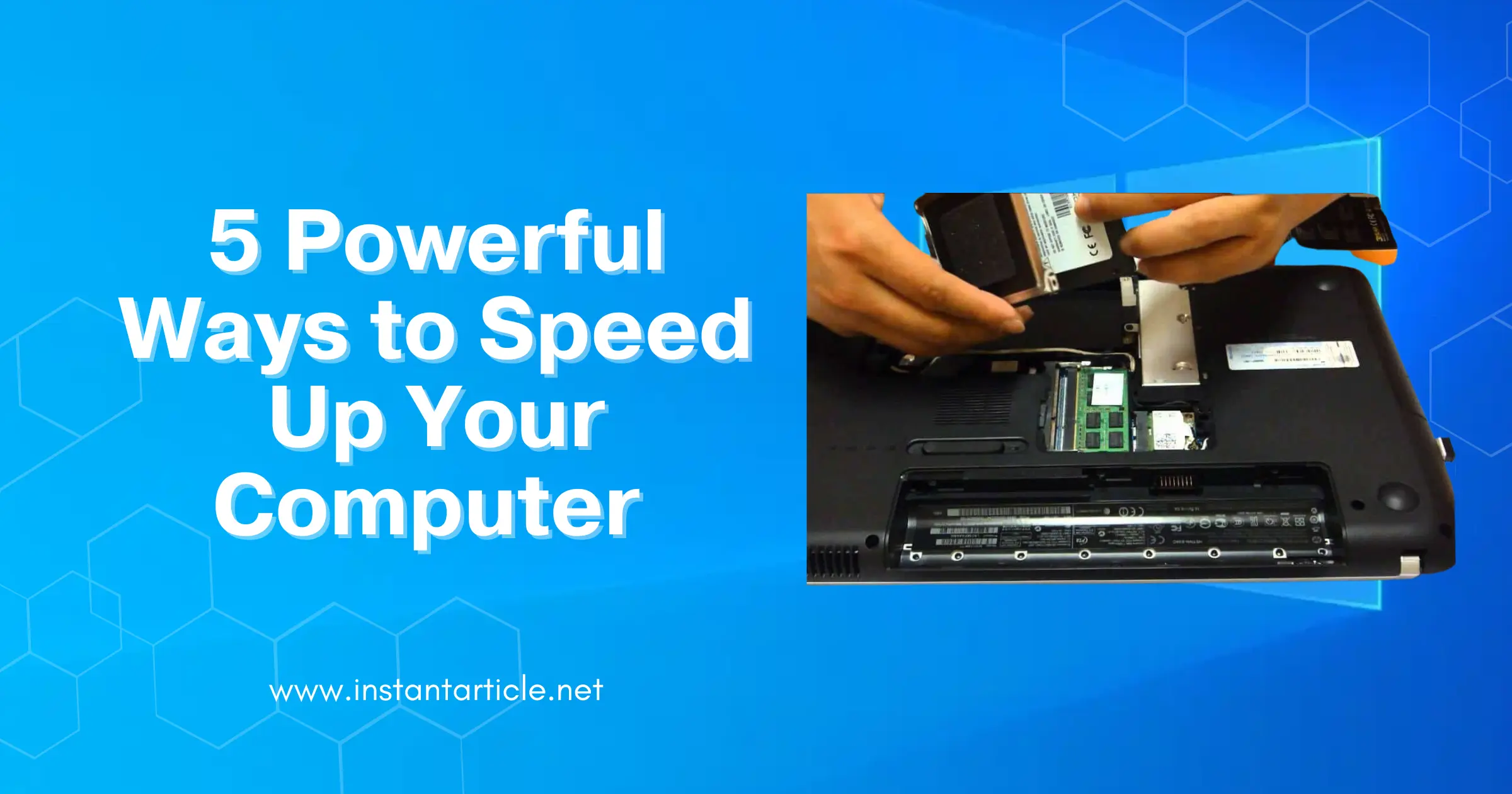Is your computer feeling sluggish lately? You’re not alone. I remember a time when my old laptop took so long to boot up that I could make a cup of coffee before it was ready to use. Like many people, I experienced a decrease in performance as my computer aged and became cluttered with files and applications. Whether you’re using your PC for work, gaming, or browsing, having a slow computer can be incredibly frustrating. Luckily, there are several effective methods you can use to give your machine a much-needed speed boost. In this article, we’ll explore five ways to speed up your computer, offering practical solutions to optimize your system’s performance.
1. Clean Up Your Hard Drive
Cleaning up your hard drive is one of the most straightforward and effective ways to improve your computer’s speed. Over time, your computer accumulates a lot of unnecessary files, including temporary files, old downloads, and system caches, which can significantly slow down your system. Here’s how to clean up your hard drive:
Remove Unnecessary Files and Applications
- Uninstall Unused Programs: Go through your list of installed programs and remove any that you no longer use. This will free up valuable space on your hard drive and reduce the load on your system.
- Delete Temporary Files: Temporary files can accumulate quickly and take up a lot of space. Use the built-in Disk Cleanup tool (Windows) or a third-party application to delete these files.
- Clear Downloads Folder: The downloads folder often becomes cluttered with files you no longer need. Regularly clean out this folder to keep your system running smoothly.
Organize Your Files
- Sort and Archive Documents: Keep your documents organized by sorting them into folders. Archive older files that you don’t access regularly but want to keep for future reference.
- Use Cloud Storage: Consider using cloud storage services like Google Drive, Dropbox, or OneDrive to store large files that you don’t need on your local hard drive.
Cleaning up your hard drive not only speeds up your computer but also helps you stay organized and efficient in your digital life.
When I first started working from home, my computer’s performance was critical. However, after just a few months, it became so slow that even opening a simple Word document was a chore. I decided to take action. I spent a weekend uninstalling programs I hadn’t used in years, and the relief was immediate. Suddenly, everything felt lighter and faster. It’s amazing how much of a difference a little cleaning can make.
2. Upgrade Your Hardware
Sometimes, the best way to speed up your computer is to upgrade its hardware. Even a few simple upgrades can make a significant difference in performance. Here are some hardware components you might consider upgrading:
Increase RAM (Random Access Memory)
- What is RAM? RAM is the memory that your computer uses to run programs and processes. More RAM allows your computer to handle more tasks simultaneously without slowing down.
- How to Upgrade RAM: Check your computer’s specifications to determine the maximum RAM capacity. Purchase compatible RAM modules and install them yourself or seek professional help.
Back when I was in college, my laptop started to lag during lectures, especially when running heavy software like Photoshop. A friend recommended upgrading the RAM. With a bit of hesitation, I bought the necessary RAM sticks and installed them myself. The difference was like night and day! Suddenly, multitasking was a breeze, and I didn’t have to worry about my computer freezing during presentations.
Switch to a Solid-State Drive (SSD)
- What is an SSD? An SSD is a type of storage device that is much faster than a traditional hard disk drive (HDD). It allows your computer to boot up faster and load applications quickly.
- How to Install an SSD: You can replace your existing hard drive with an SSD or add an SSD alongside your current drive. Clone your existing data onto the new SSD to retain your files and operating system.
Watch: Steps on How to Install an SSD in Your Laptop
Upgrade Graphics Card
If you use your computer for gaming or graphic-intensive tasks, upgrading your graphics card can improve performance. A more powerful graphics card can handle higher resolutions and better graphics settings.
Enhance Detail with Case Study
According to a report by PCMag, upgrading from an HDD to an SSD can reduce boot times by over 60%. In a recent test, a computer with a traditional HDD took 45 seconds to boot up, whereas the same system equipped with an SSD booted up in just 15 seconds. This change can be transformative for professionals who rely on their computers for quick and efficient work.
Upgrading your hardware might involve some initial investment, but the increase in performance and efficiency is often worth it.
3. Optimize Startup Programs
Every time your computer boots up, it runs a series of programs in the background. Some of these programs are essential, while others are unnecessary and can slow down your startup time. Optimizing your startup programs can lead to a faster boot-up and overall better performance.
Manage Startup Applications
- Windows Users: Use the Task Manager to view and manage startup programs. Press
Ctrl + Shift + Esc, navigate to the Startup tab, and disable programs you don’t need to start automatically. - Mac Users: Go to System Preferences > Users & Groups > Login Items. Remove any unnecessary items from the list.
Use a Startup Manager Tool
There are several third-party tools available that can help you manage your startup programs more effectively. These tools offer more control and provide insights into which programs are impacting your startup time the most.
A while ago, I had a particularly frustrating experience where my computer would take forever to boot up. After some research, I discovered that several unnecessary programs were set to start with Windows. Disabling these programs cut my startup time in half. It felt like a fresh start for my computer and was such a simple fix!
By optimizing your startup programs, you’ll experience faster boot times and a more responsive computer.
4. Keep Your System Updated
Keeping your operating system and software up-to-date is crucial for maintaining optimal performance and security. Software updates often include performance improvements and bug fixes that can help speed up your computer.
Enable Automatic Updates
- Operating System Updates: Ensure that automatic updates are enabled for your operating system. This will keep your system running smoothly and protected against security threats.
- Software Updates: Check for updates for your installed applications regularly. Many programs offer automatic updates, which you should enable if possible.
Update Drivers
Drivers are software components that allow your hardware to communicate with your operating system. Outdated drivers can cause performance issues and compatibility problems. Regularly check for driver updates from your computer manufacturer or hardware vendors.
Case Study: Why Updates Matter
In 2022, a security vulnerability was discovered in a popular operating system that could potentially allow hackers to access users’ personal information. The company quickly released a patch to fix the issue. Users who kept their systems updated were protected, while those who delayed faced significant risks. This incident underscores the importance of regular updates for both performance and security.
Staying on top of updates is an easy way to ensure your computer is running at its best.
5. Protect Against Malware and Viruses
Malware and viruses can significantly slow down your computer and pose serious security risks. Protecting your system from these threats is essential for maintaining performance and keeping your data safe.
Install Antivirus Software
- Choose Reliable Antivirus Software: Select a reputable antivirus program that provides real-time protection against malware and viruses. Popular options include Norton, McAfee, and Bitdefender.
- Run Regular Scans: Schedule regular scans to detect and remove any malicious software that may have infiltrated your system.
Use Anti-Malware Tools
In addition to antivirus software, consider using dedicated anti-malware tools. These programs can detect and remove potentially unwanted programs (PUPs) and other threats that might not be caught by traditional antivirus solutions.
Practice Safe Browsing
Be cautious when downloading files or clicking on links from unknown sources. Avoid visiting suspicious websites and use a browser extension to block malicious ads and trackers.
Real-Life Example
A colleague once downloaded a seemingly harmless file from an unknown source. Almost immediately, her computer slowed to a crawl, and pop-ups began to appear. It turned out that the file was infected with malware. After installing and running a reliable antivirus program, the issue was resolved, and the computer’s performance returned to normal. This experience highlights the importance of vigilance and using security software.
By protecting your computer against malware and viruses, you can ensure that it runs smoothly and securely.
Frequently Asked Questions (FAQs)
Regular maintenance is key. Aim to clean up your hard drive at least once every few months to keep your system running smoothly.
Upgrading RAM is usually straightforward, especially in desktops. However, laptops might be more challenging due to compact design. If you’re unsure, consider seeking professional help.
Yes, SSDs significantly improve boot times and application load speeds, offering a noticeable boost in overall system performance.
Signs of malware include slow performance, unexpected pop-ups, and programs crashing frequently. Running a full system scan with antivirus software can help detect and remove malware.
While many drivers update automatically, it’s a good idea to manually check for updates periodically, especially for critical components like graphics cards and network adapters.
Yes, having too many startup programs can slow down your computer’s boot time. Disable unnecessary programs to speed up the process.
Conclusion
By implementing these five powerful strategies, you can significantly speed up your computer and enhance its performance. Whether you’re cleaning up your hard drive, upgrading hardware, optimizing startup programs, keeping your system updated, or protecting against malware, each step contributes to a faster and more efficient computer. Regular maintenance and proactive measures will keep your machine running smoothly, allowing you to enjoy a more productive and frustration-free computing experience.

